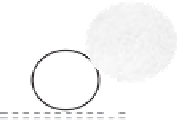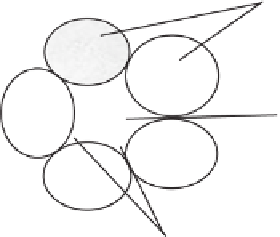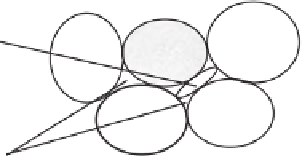Environmental Engineering Reference
In-Depth Information
Soil particles
1
2
Collapsible pore
2
5
5
1
3
4
3
4
Noncollapsible pores
(interconnected pores)
(a)
(b)
Figure 13.31
Two types of pores in soil: (a) before collapse and (b) after collapse (from Pham,
2002).
where:
0.20
Dry density
1.8 Mg/m
3
1.5 Mg/m
3
C
c
,C
s
=
compression index of the pore having a vol-
ume of
v
p
(
0
,
1
)
at the reference stress state
(i.e., zero soil suction, 1 kPa net mean stress),
0.16
Intra-aggregate
Inter
-aggregate
0.12
v
p
(
0
,
1
)
=
volume of the pore at the reference stress state,
V
p
(
0
,
1
)
=
total volume of all pores in the soil at the ref-
erence state,
0.08
C
c
=
virgin compression index of the soil, and
0.04
C
s
=
unloading-reloading index of the soil.
0.00
Assumption 6.
Pores are deformed and water is either
absorbed or drained through processes independent of net
mean stress change. Two types of physically based models
have been proposed to represent
1
10
100
1000
10,000
100,000
Pore diameter, (nm)
Figure 13.32
Mercury intrusion test results showing pore-size
distribution of two montmorillonite soil samples compacted at dif-
ferent dry densities (after Lloret et al., 2003).
the hysteretic nature
of SWCCs:
(i) independent models and (ii) dependent
models.
Independent models assume that absorption or drainage of
water from a pore is independent of the surrounding pores.
Dependent models take into account the effect of blockage
from surrounding pores (Pham, 2002, 2005). Independent
models are simpler to use and appear to provide an adequate
representation of hysteresis associated with SWCCs (Everett,
1955; Topp, 1971; Poulovassilis and Childs, 1971; Mualem,
1973, 1974; Pham, 2002; M.D. Fredlund et al., 2003).
Noncollapsible pores are assumed to be incompressible (i.e.,
assumption 3). Collapsible pores are assumed to deform
independently once the noncollapsible pores do not change
volume.
Assumption 7.
The unloading-reloading index of an air-
filled pore is approximately zero. Silva et al., (2002) assumed
that the unloading-reloading index of an unsaturated soil under
constant soil suction decreases with each suction increment.
Under completely dry conditions (i.e., soil suction equal to
10
6
kPa), the unloading-reloading index for the soil structure
is assumed to approach zero and unloading-reloading indices
for the soil pores also approach zero (Vilar and Davies, 2002;
Lloret et al., 2003).
conditions. Consequently, there should be little hysteresis
between the wetting curve and the drying curves at water
contents lower than the residual water content.
Assumption 5.
Virgin compression and unloading-
reloading indices for a pore in the soil are proportional to the
pore volume at the reference stress state (i.e., loading from
1 kPa net mean stress and zero soil suction).
This assumption 5 indicates that larger pore sizes result in
higher virgin compression and unloading-reloading indices
(Pham, 2005). If this assumption and assumption 3 are
combined, the virgin compression and unloading-reloading
compression indices of a pore can be calculated from the
virgin compression and unloading-reloading indices of
the soil:
v
p
(
0
,
1
)
V
p
(
0
,
1
)
C
c
C
c
=
(13.88)
v
p
(
0
,
1
)
V
p
(
0
,
1
)
C
s
C
s
=
(13.89)














































































Search WWH ::

Custom Search